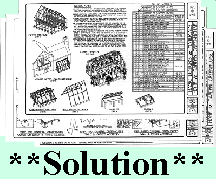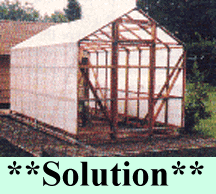|
|
|

PLANNING YOUR GREENHOUSE LOCATION
After you have decided which kind of greenhouse you want, you will need to determine where you are going to put it. The first choice for a site should be on the south or southeast side of the house in a sunny location. The east side is the second best location. That's where it will capture the most November to February sunlight. The next best locations are the southwest and west. The north side is the least desirable location. You can place your structure where it will be partly shaded during the summer when light reduction is not serious and may be desirable. Be sure to take into account the possibility of falling limbs that can damage the structure.
Some plants will grow in a greenhouse in any location. African violets and orchids, for example, will grow with northern exposure - but heating costs will be high. You will limit the types of plants you can grow if you don't put your structure in the best possible location. Sometimes you can place a structure against a door, window, or basement entrance of your house. This will let you use heat from your house to grow plants, make your structure more accessible, and save on construction costs. Your home heating bill, however, will increase significantly. If you have an L-shaped house, you can save the cost of 2 walls by building in the "L".
Whether your structure runs north and south or east and west is not so important as wind protection. Protect your building from winds by locating it so existing buildings will shield it, or by providing it with a windbreak hedge or fence.
Note
An ideal site would be one that is well-drained, nearly level, and has full southern exposure to sunlight. It would slope slightly to the south and have a windbreak on the side of the prevailing wind.
BASIC GREENHOUSE DESIGN
You will need to determine the exact dimensions before you start to build. Width is the most important dimension; it will not be changed during the life of the structure. Length can be increased if more space is desired.
Structure Width:
Determine the width by adding the widths of the plant benches and the walks. Allow approximately 6 inches for an air-circulation space between the side walls and the benches. Side benches are serviced from only one side and should be no wider than you can reach across. For some people this will be 2 feet, for others perhaps as much as 3 feet. Center benches are serviced from both sides and can be as wide as 6 feet. They should be no wider than to permit you to work comfortably.
Determine the width of the walks inside the structure by how they are to be used. If the walks will be used only as a place to stand while servicing the benches, an 18- or 19-inch walk is sufficiently wide; if a wheelbarrow will be brought into the building, the width must be greater. Wide walks - 24 to 30 inches - will allow easy passage for visitors who may not be used to walking between rows of plants.
Structure Length:
Determine the length by multiplying the number of plants you can grow across the benches by the number of plants you want to grow. Then round off the measurement so that no glass will need to be cut to fill odd sash bar spacing. (A sash bar is a shaped wooden or metal bar used in the construction of a sash or frame and designed to hold and support the glass secure to it.)
Standard glass sizes are 16 x 24, 18 x 20, and 20 x 20 inches. (Larger glass sizes means few sash bars and less shadow inside the structure.) Most plastics are available in 100-foot lengths. When you figure the length of a glass structure, allow for the width of the projecting part of each sash bar plus a fraction of an inch clearance. For plastic, allow an extra 24 inches to fasten the plastic properly.
Structure Height:
The height depends on the desired height to the eave. An eave height of 5 feet is satisfactory for side benches with low-growing plants. If you want to grow tall plants, however, you will want an eave height of 6 or 7 feet. The pitch of the roof should be 6 in 12 (approximately 27 degrees). The eave height, the distance from the side wall to the center of the structure, and the roof pitch will determine the height of your structure at the center. The height of the structure should be equal to the eave height plus one-fourth the width.
For instance, in an even-span unit 18 feet wide, the distance from the side wall to the center of the structure is 9 feet. The difference in height between the center of the structure and the eave will be one half of 9 feet, or 4 feet. If the eave is 5 feet high, the structure should be 9 feet at the center.
To Learn More About Planning Select Your Area of Interest by 'Clicking' on the Index Text Below.
TYPES OF GREENHOUSES & CONSTRUCTION
GREENHOUSE COLD FRAMES, HOTBEDS & PROPAGATING FRAMES
GREENHOUSE VENTILATION & COOLING
GREENHOUSE LIGHTING, TEMPERATURE AND CONTROL
|
Copyright 2006, All Rights Reserved Including Page and Website "Look & Feel" |

"A Company with Products & Services to Enrich Your World"


